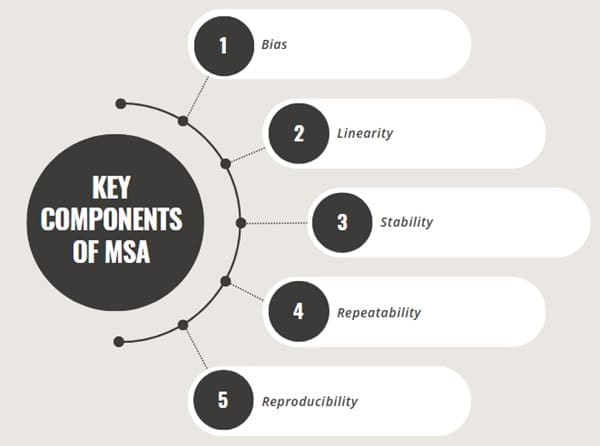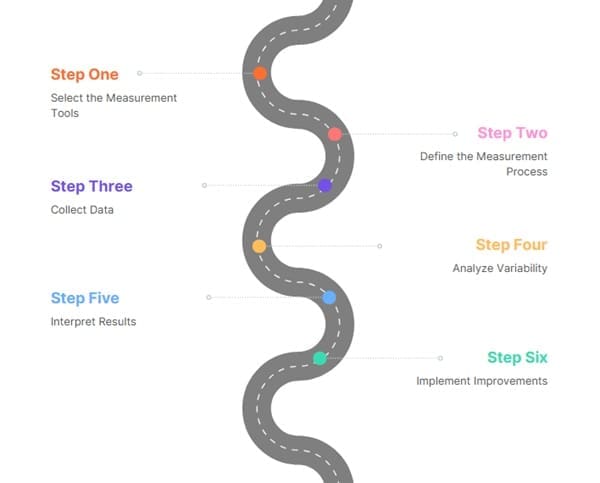In manufacturing, accurate measurements are crucial. They guide decisions on process improvements. Measurement System Analysis (MSA) helps ensure these measurements are reliable.
MSA evaluates the quality of measurement systems. It identifies variations that can affect data accuracy. By understanding these variations, manufacturers can improve product quality and process efficiency.
MSA is a method to evaluate the quality of a measurement system. It helps you understand how much variation in your measurements is due to the measurement system itself, rather than actual differences in the things you’re measuring.
Table of contents
What is Measurement System Analysis?
MSA is a collection of experiments and analyses. It evaluates a measurement system’s capability and performance. The goal is to quantify measurement uncertainty. This involves reviewing data collection methods and tools. MSA assesses the accuracy, precision, and stability of measurements.
Measurement System Analysis (MSA) is a crucial process used to evaluate the quality of a measurement system. Essentially, it’s about ensuring that the data you collect from your measurements is reliable and trustworthy. Here’s a breakdown:
Core Purpose:
MSA aims to quantify the amount of variation within a measurement process. This variation can stem from the measurement tools, the operators, or the measurement process itself.
It helps determine if a measurement system is suitable for its intended purpose.
Why is MSA Important?

Reliable data is essential for informed decision-making. Without MSA, measurement errors can lead to incorrect conclusions. This may result in wasted time, labor, and resources. An effective MSA process ensures that data collected is accurate. It also verifies that data collection methods are appropriate for the process.
Reliable Data:
Any decisions you make based on your measurements will also be off if your measurements are off. MSA helps you get accurate data.
Quality Control:
In manufacturing, for example, you need to know if your products meet certain standards. MSA ensures that your measurements are accurate enough to make those judgments.
Process Improvement:
When you’re trying to improve a process, you need to know if your changes are actually making a difference. MSA helps you see if the changes you’ve made are reflected in your measurements.
Reducing Waste:
If you think that a product is out of specifications, when in reality the measurement system is wrong, then you will be throwing away good products. MSA prevents this.
What Makes Up a Measurement System?

A measurement system isn’t just the tool you use. It includes:
- Equipment: This is the actual measuring device, like a scale, a ruler, or a calliper.
- People (Operators): The people who take the measurements. Their skill, training, and how consistently they follow the procedure are important.
- Process: The steps involved in taking the measurements. This includes how the equipment is used, how the readings are recorded, and any other procedures.
- Environment: Factors like temperature, humidity, and vibrations can also affect measurements.
- Parts: The items being measured.
Key Components of MSA

MSA involves evaluating several components that contribute to the overall reliability and accuracy of the measurement system. These components are crucial in identifying where variability or errors might exist within the system.
- Bias: Bias refers to a consistent difference between the measured value and the true value of what is being measured. Bias occurs when a measurement system is systematically off in one direction, either overestimating or underestimating the value. Bias is a critical component because it indicates a systematic error in the measurement process that could lead to inaccurate data.
- Linearity: Linearity assesses whether bias changes as the measurement range changes. If a measurement system is linear, the error introduced by the system should remain consistent across all measurements. If the system is non-linear, the amount of error may vary depending on the measurement value, leading to inconsistent data across different ranges.
- Stability: Stability refers to the ability of the measurement system to maintain its accuracy over time. A stable system consistently provides the same results when measuring the same object at different points in time. If a measurement system is unstable, it may start providing inaccurate results, even if it was initially accurate.
- Repeatability: Repeatability is the ability of a measurement system to give consistent results when the same operator measures the same item under the same conditions multiple times. High repeatability means that the system is precise and can be trusted to produce consistent results when measurements are repeated.
- Reproducibility: Reproducibility refers to the consistency of measurement results when different operators use the measurement system. Even when different individuals measure the same object, the measurement system should produce consistent results. Variability in reproducibility often indicates that the operators’ skills or the equipment may be contributing to the measurement errors.
Types of MSA Studies
- Bias Study: Evaluates the difference between the average observed value and the true value. It helps identify systematic errors in the measurement system.
- Linearity Study: Assesses how bias changes across the measurement range. It ensures that the measurement system’s accuracy is consistent throughout its operating range.
- Stability Study: Monitors bias over time to detect any shifts or drifts. Stability studies help identify long-term trends or changes in the measurement system’s performance.
- Gage Repeatability and Reproducibility (Gage R&R) Study: Combines repeatability and reproducibility assessments. It involves multiple operators measuring multiple parts to evaluate the measurement system’s overall variability.
- Attribute Measurement Study: Used for attribute data (e.g., pass/fail). It assesses the consistency of categorical measurements, such as visual inspections or go/no-go gauges.
How MSA is Done?
MSA involves conducting studies to evaluate your measurement system. Here’s a general idea:
- Gage R&R (Repeatability and Reproducibility) Study: This is a common type of MSA study. It involves having multiple people measure the same parts multiple times. This helps you determine how much of the variation in your measurements is due to the equipment (repeatability) and how much is due to the people (reproducibility).
- Bias Studies: These studies compare your measurements to a known standard to determine if there is any bias.
- Linearity Studies: These studies check the accuracy of your measurements across the range of values you’re measuring.
- Stability Studies: These studies monitor your measurements over time to see if there are any changes in accuracy or precision.
How to Perform a Measurement System Analysis?

To conduct a successful MSA, the following steps are typically followed:
- Select the Measurement Tools
Begin by choosing the appropriate measurement tools or instruments for the study. The tools selected should be suitable for the type of measurements being taken, whether they are physical dimensions, weight, temperature, etc. - Define the Measurement Process
Clearly define the procedures for taking measurements. This step ensures that all operators follow the same method when measuring parts or products, reducing variations introduced by procedural differences. - Collect Data
Multiple operators should take measurements on the same items several times. This helps to assess both repeatability (variability within the same operator) and reproducibility (variability between different operators). - Analyze Variability
Use statistical techniques to analyze the collected data. These techniques will help identify the sources of variability within the measurement system. Variability is typically analyzed using techniques like Analysis of Variance (ANOVA) or standard deviation calculations. - Interpret Results
After analyzing the data, interpret the results to determine if the measurement system is acceptable. If the variability is too high, corrective actions may be needed. - Implement Improvements
If the analysis reveals problems with the measurement system, improvements are necessary. This could involve recalibrating tools, training operators, or adjusting the measurement process to reduce variability and improve accuracy.
Best Practices for MSA
To ensure that MSA studies are effective, the following best practices should be followed:
- Use Representative Samples: Always select parts that represent the full range of variability in the process to ensure the MSA study is accurate and comprehensive.
- Involve Experienced Operators: Ensure that the individuals conducting the study are familiar with the measurement process and have the skills necessary to perform the measurements accurately.
- Standardize Procedures: All operators should follow standardized procedures to ensure that variability is due to the measurement system itself and not differences in how measurements are taken.
- Document Findings: Maintain clear documentation of the study, including the methods used, the data collected, and any conclusions or recommendations. This ensures that results can be reviewed in the future if needed.
- Reassess Regularly: Measurement systems may change over time, so it’s important to conduct periodic MSAs to monitor the ongoing accuracy and reliability of the measurement systems.
Final Words
Measurement System Analysis is vital for ensuring data quality in manufacturing. It helps identify and reduce variations in measurement systems. By implementing MSA, manufacturers can make informed decisions. This leads to improved product quality and process efficiency. Regular MSAs are essential for maintaining reliable measurement systems.


















